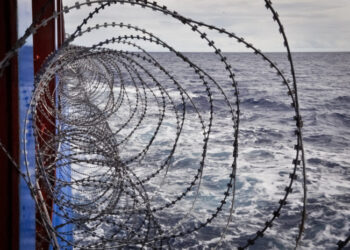Maersk announced that will cooperate with the American technology company, IBM, for the creation of a global trade digitisation solution, that will move all administrative processes and transactions associated with one container shipment—more than 200 interactions involving more than 30 people according to Maersk research—to the internet.
The global trade digitisation solution with blockchain will enable the real-time exchange of original supply chain events and documents through a secure digital infrastructure, or data pipeline, that connects supply chain participants from shippers and logistics providers to customs authorities, allowing greater visibility and flow of important information, with much greater security.
“The projects we are doing with IBM aim to explore disruptive technology such as blockchain to solve real customer problems and create new innovative business models for the entire industry. As a global integrator of container logistics with the ambition to digitise global trade, we are excited about this cooperation and its potential to bring substantial efficiency and productivity gains to global supply chains, while decreasing fraud and increasing security,” says Ibrahim Gokcen, Chief Digital Officer for A.P. Moller – Maersk.
In particular, for shippers, the solution can help reduce trade documentation and processing costs and help eliminate delays associated with errors in the physical movement of paperwork. It will also provide real time insight into cargo as it advances through the supply chain.
For customs authorities, the solution will give real time visibility, significantly improving the information available for risk analysis and targeting, which will lead to increased safety and security as well as greater efficiency in border inspection clearance procedures.
With the global trade digitisation solution, Maersk and IBM develop real-time exchange of original supply chain events and documents among supply chain participants. From shippers and logistics providers to customs authorities, each participant gets greater visibility and access to the flow of important information with much greater reliability and security. There will be no more physical, time-consuming and error prone processes, just uploads, downloads, clicks and swipes.
“The projects we are doing with IBM aim to explore disruptive technology such as blockchain to solve real customer problems and create new innovative business models for the entire industry,” says Gokcen. “We expect the solutions we are working on will not only reduce the cost of goods for consumers, but also make global trade more accessible to a much larger number of players from both emerging and developed countries.”
“The Customs Administration of the Netherlands sees this data pipeline as a tool supporting the balance between trade facilitation and enforcement, where information sharing in supply chains is optimized from a commercial perspective, and government authorities can re-use that information flow for supervision purposes,” said Frank Heijmann, Head of Trade Relations, Customs Administration of the Netherlands. It supports the needs of trade and governments in global supply chains, as it improves efficiency, compliance and security. The supply chain visibility serves all of those needs.”
How it works:
- Blockchain, an immutable, security rich and transparent shared network, provides each participant end-to-end visibility based on their level of permission.
- Each participant in a supply chain ecosystem can view the progress of goods through the supply chain, understanding where a container is in transit. They can also see the status of customs documents, or view bills of lading and other data.
- Detailed visibility of the container’s progress through the supply chain is enhanced with the real time exchange of original supply chain events and documents.
- No one party can modify, delete or even append any record without the consensus from others on the network.
- This level of transparency helps reduce fraud and errors, reduce the time products spend in the transit and shipping process, improve inventory management and ultimately reduce waste and cost.
For further information, you may watch the following video:
https://www.youtube.com/watch?v=dcddYatMCGQ
The following infographic shows how blockchain technology can open the market to new producers:

Source: Maersk Line




























































